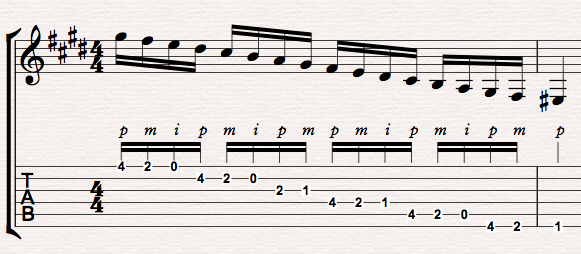That’s great, I would do that too. Other stuff I would play with p-m only.
In my personal opinion, you are looking at this the wrong way. The passage you want to play dictates which finger to use for each note, and not the other way around. There is no way to know this beforehand, if you haven’t analysed and practiced the entire passage in some form. Also, even when using strict p-m-i, there are often two possible ways of playing the same sequence.
That I can provide, at least for what I came up with. It goes like this:
-
You avoid playing ascending string changes with the thumb, except if it can be played as a sweep following another thumb that came before on the lower string
-
You avoid descending string changes with any of the opposing fingers, if the note before was played on a higher string with the thumb
That gives you this set of possible string changes:
p-m
- ascending with “m” (or “p” if it can be swept)
- descending with “p” (or “m” if it can be swept)
p-m-i
- ascending with “m” or “i” (or p if it can be swept)
- descending with “p” or “i” (“m” only if it can be swept)
p-a-m-i
- ascending with any finger (“p” only if…)
- descending with “p”, “m”, “i” (“a” only if…)
BUT what I would recommend doing is to play everything with a simplified p-m-i + p-m approach.
- Every descending string change with “p”
- Every ascending string change with “m”
One of the most dreaded scales in classical guitar would then look like this:

I would play like this until I felt really secure, and gradually try to include sweeps for string changes that you can’t get otherwise. If this was really working at a decent enough speed, like 150 bpm for 16ths, I would gradually include the two other string changes possible with p-m-i, descending with “i” an ascending with “i”.
As for this:
The main difference is, where your point of contact with the string is. The classical approach would be to try to always use the pocket where the nail meets the flesh. Regardless of nail length, together with plucking rather close to the soundhole (compared to flamenco or Tommy Emmanuel)) that gives you the more bell/harp like sound of classical guitar. Longer nails help with the volume and enhance this quality of the sound. But the way you are playing (with calluses/fingertips, string maybe hitting a bit of nail on the way?) is totally fine. That is how you get a more “flamenco” sound on nylon btw. It doesn’t change the technique at all. But maybe try that (EDIT: plucking where the nail meets the flesh) too?
Hope this helps
EDIT:
You can of course always incorporate the traditional 3-string arpeggio with p-m-i, even if that doesn’t fit my set of “rules”




